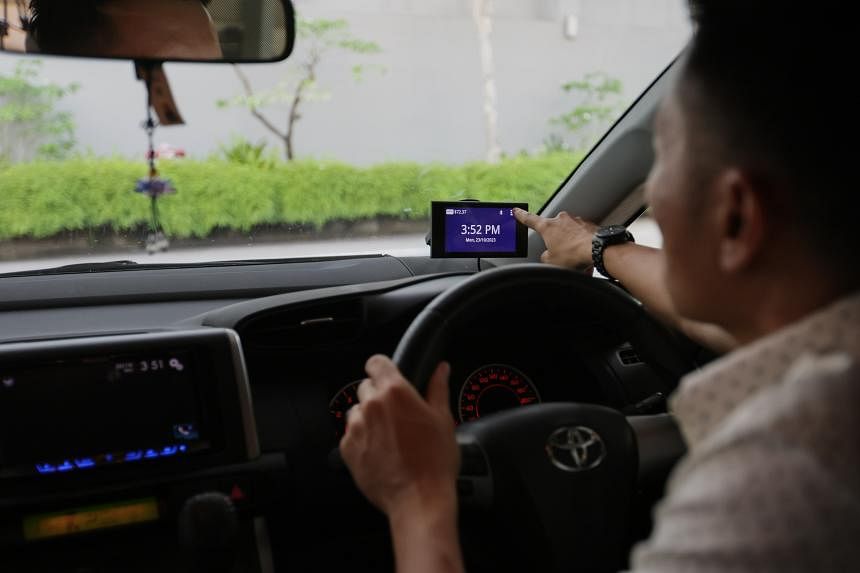SINGAPORE – Authorised car distributors said they will be ready to install on-board units (OBUs) for the satellite-based Electronic Road Pricing system on vehicles, although most motorists that The Straits Times spoke to had reservations about the change.
The Land Transport Authority (LTA) announced on Monday that it will start fitting the OBUs for the next-generation ERP system, or ERP 2.0, on fleet vehicles from November, with the exercise for privately owned vehicles to start in batches after that. The exercise is expected to be completed by end-2025.
The three-piece OBU for vehicles will be provided free to motorists during the installation period.
Motor dealerships said they were approached by LTA in 2020 for feedback on where the three components – an antenna, a processing unit and a touchscreen display – would fit in vehicles.
Ms Renee Chua, managing director of Rolls-Royce Motor Cars Singapore, said the company has worked out a way to conceal the wiring needed by the OBU.
Customers buying new cars can decide whether to fit the touchscreen display, she added. The LTA had said that new vehicles will be fitted with the OBU from the first quarter of 2024.
Motorists can opt not to fit the display and access ERP-related information on mobile applications instead – an option that the LTA provided in response to public feedback that the OBU is bulky.
Ms Tracy Teo, marketing director of Komoco Motors, which represents Hyundai, Jeep, Ferrari, Maserati and Alfa Romeo in Singapore, said the company is awaiting information and instruction from LTA on the next steps.
Mr Jeremy Ng, 46, who works at a private bank, said the three-piece OBU looks cumbersome, and he would likely opt not to have the touchscreen for his BMW M3.
He is also concerned that the processing unit – which will be installed on the side of the front passenger footwell – may get in the way of a passenger wanting to brace himself against that area for support, like when the car is taking a corner at higher speeds.
Mr Kelvin Tan, who works in sales, called the OBU solution a step backwards.
The 50-year-old noted that contactless payment provider EZ-Link has a smartphone app to top up stored value cards and payments. “Even EZ-Link has gone app-based, why do we need to have to carry a gadget in the car?”
LTA has said that an entirely smartphone-based system will not offer the security and features that the current ERP 2.0 system is designed to provide.
Mr Xavier Wong, who is in his 50s and working with a venture capitalist, said he would prefer not to install the display. “I believe later iterations of the OBU will likely be more compact,” he added.
Mr Klive Lee, 54, who runs his own advertising agency, is among those who have no qualms about the OBU or the need to make an appointment to get it installed in his car.

Before Monday’s announcement, the LTA had conducted a pilot exercise to fit 500 vehicles with the OBU, which included 110 cars, motorcycles and trucks from Certis Cisco.
Mr Alvin Lim, vice-president and head of Certis Cisco Secure Logistics, said the installation took about two months to complete.
Mobile installation teams were sent to the company’s location at Bedok South and the installation took place in batches, so Certis’ regular work scheduling was not disrupted.
Mr Lim said the company’s drivers found the reminders from the touchscreen display on bus lanes and speed cameras particularly useful.
The fleet’s ERP and carpark charges are handled by the EZ-Link Motoring Corporate service, which is a “post-paid” payment service that does not require a physical stored value card to be in the OBU’s processing unit or the current in-vehicle unit (IU). This reduces the administrative work of verifying transactions and having to top up physical cards.
In 2016, the LTA had awarded a $556 million contract to NCS and MHI Engine System to develop the ERP 2.0.
Back then, the LTA said it would look into phasing in distance-charging after a transition phase into ERP 2.0. No timeline was set.
On Monday, the authority said while ERP 2.0 is able to charge motorists based on the distance they clock, it has no immediate plans to introduce distance-based charging.
There will be no change to how motorists are currently charged for ERP during the transition period, LTA said, without elaborating on how long the transition would be.
Mr Klive Lee, for one, hopes that distance-based charging will come into effect soon as it feels “correct – if you drive more, you pay more”.


